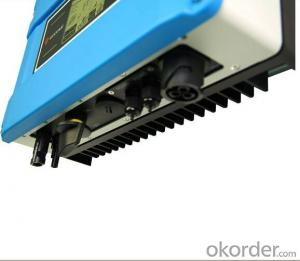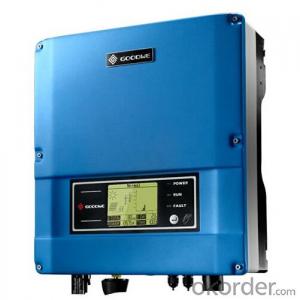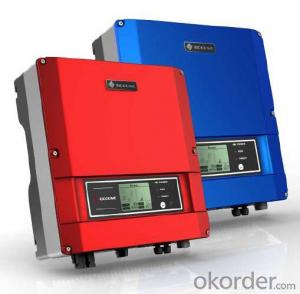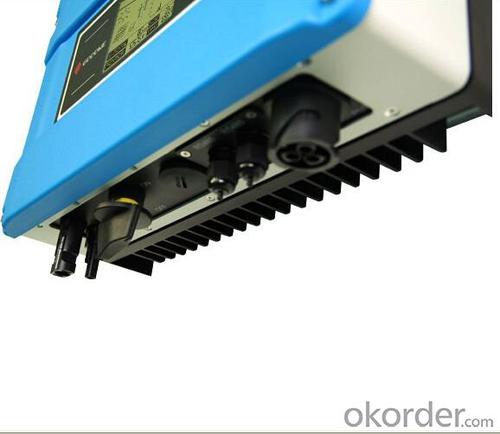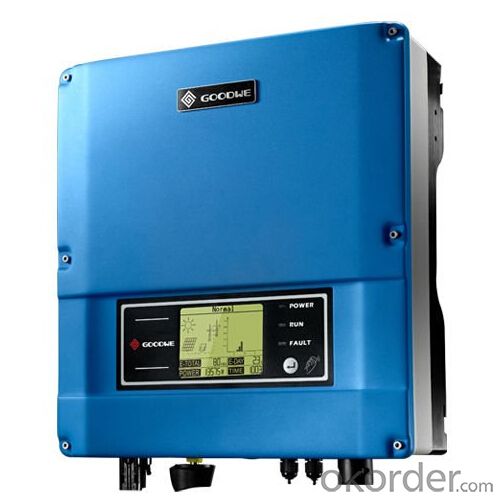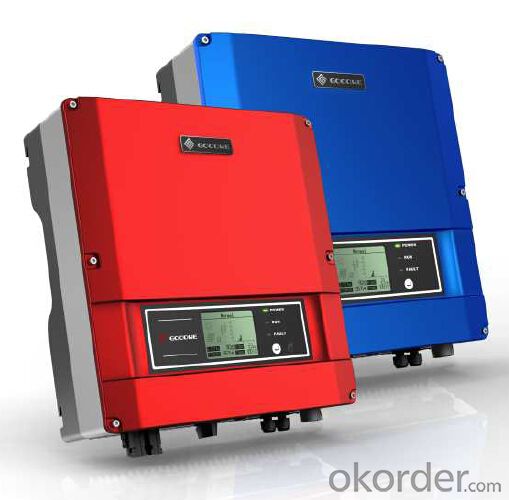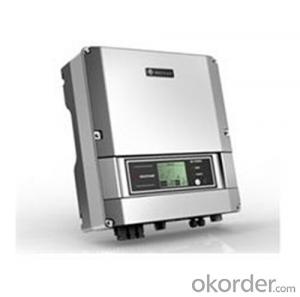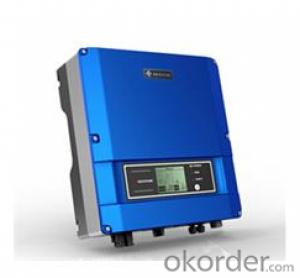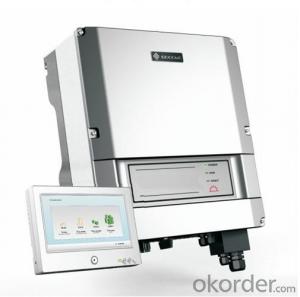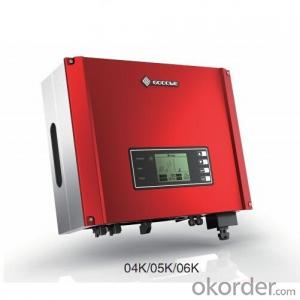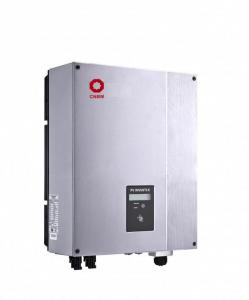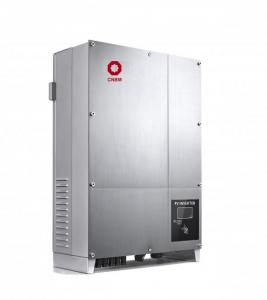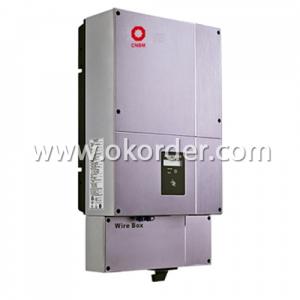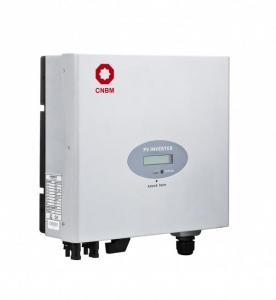Fuji Solar Inverter GW4000-SS On Grid Solar Inverter
OKorder Service Pledge
Quality Product, Order Online Tracking, Timely Delivery
OKorder Financial Service
Credit Rating, Credit Services, Credit Purchasing
You Might Also Like
GW4000-SS photovoltaic inverter is suitable for home rooftop photovoltaic system, designed under modern industrial concept.
There are three colors for option with fashionable appearance.
According to the test results of PHOTON laboratory, the medium irradiation efficiency is 96.9% and high irradiation efficiency is 97.1%.
It has obtained Double A Certificates. It holds a safe lead among the same level of products in the world.
Datasheet
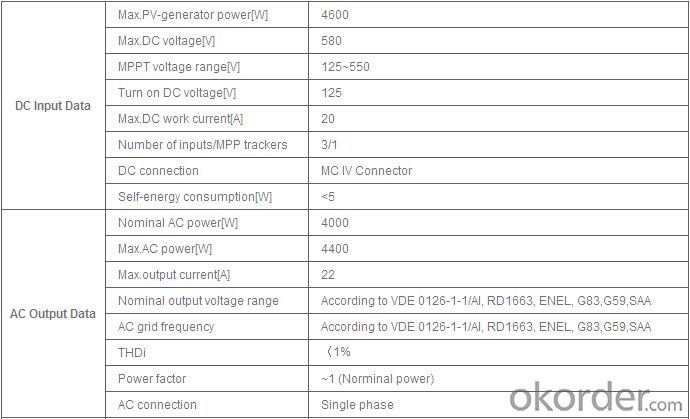
- Q: What is the role of a grid-tie inverter in a solar PV system?
- The role of a grid-tie inverter in a solar PV system is to convert the direct current (DC) electricity generated by the solar panels into alternating current (AC) electricity that can be fed directly into the electrical grid. It synchronizes the electricity produced by the solar panels with the grid's frequency and voltage, allowing the excess energy to be sent back to the grid for use by other consumers.
- Q: What is the role of a power optimizer in a solar inverter?
- The role of a power optimizer in a solar inverter is to maximize the energy output of each individual solar panel in a solar power system. It works by continuously monitoring and optimizing the performance of each panel, ensuring that it operates at its maximum power point. This helps to overcome shading, mismatch, and other factors that can negatively impact the overall system efficiency. By optimizing the power output of each panel, power optimizers enhance the overall energy production of the solar power system, leading to increased electricity generation and improved system performance.
- Q: How efficient are solar inverters?
- Solar inverters are highly efficient, with most modern models achieving efficiency levels above 95%. This means that they can convert a large majority of the direct current (DC) electricity generated by solar panels into alternating current (AC) electricity for use in homes or businesses. The high efficiency of solar inverters helps maximize the overall energy output and financial benefits of solar power systems.
- Q: What is the role of reactive power control in a solar inverter?
- The role of reactive power control in a solar inverter is to manage and regulate the flow of reactive power in the electrical system. It helps to maintain a stable voltage level, improve power factor, and ensure efficient operation of the solar inverter. By controlling reactive power, the inverter can mitigate voltage fluctuations and provide optimal power quality, making the system more reliable and compliant with grid requirements.
- Q: What are the advantages of using a solar inverter?
- There are several advantages of using a solar inverter. Firstly, solar inverters convert the direct current (DC) generated by solar panels into alternating current (AC), which is the type of electricity used in most homes and businesses. This allows for the seamless integration of solar power into the existing electrical grid. Secondly, solar inverters optimize the performance of solar panels by constantly monitoring and adjusting the voltage and current levels. This ensures that the panels are operating at their maximum power output, resulting in higher energy efficiency and increased electricity production. Moreover, solar inverters enable net metering, which allows excess solar energy to be fed back into the grid, effectively spinning the electricity meter backward. This can lead to significant savings on electricity bills or even generate income through feed-in tariffs. Additionally, solar inverters offer advanced monitoring capabilities, allowing homeowners and system operators to track the energy production and performance of their solar systems in real-time. This data enables better system maintenance, troubleshooting, and optimization. Lastly, solar inverters contribute to a cleaner and more sustainable energy future by reducing dependence on fossil fuels and minimizing greenhouse gas emissions. They play a crucial role in harnessing the power of the sun to generate clean, renewable energy.
- Q: Can a solar inverter be used in regions with high levels of electromagnetic interference?
- Yes, a solar inverter can be used in regions with high levels of electromagnetic interference. However, it is important to ensure that the inverter is designed and manufactured to meet the necessary electromagnetic compatibility (EMC) standards and has the appropriate shielding measures in place to minimize any interference or disruption caused by electromagnetic noise.
- Q: What are the key factors affecting the compatibility of a solar inverter with other system components?
- The key factors affecting the compatibility of a solar inverter with other system components include the voltage and frequency requirements of the inverter, the capacity and type of the solar panels being used, the type and capacity of the battery storage system, and the overall electrical load of the system. Additionally, the communication protocols and interfaces supported by the inverter and other components play a crucial role in ensuring compatibility and seamless integration within the system.
- Q: Can a solar inverter be used with a solar carport?
- Yes, a solar inverter can be used with a solar carport. The solar inverter is responsible for converting the direct current (DC) generated by the solar panels into alternating current (AC) that can be used to power various electrical devices, including electric vehicles parked under the solar carport.
- Q: Can a solar inverter be used with micro-inverters?
- Yes, a solar inverter can be used with micro-inverters. In fact, micro-inverters are designed to work in conjunction with a central solar inverter. The role of the micro-inverter is to convert the DC power generated by individual solar panels into AC power, which can then be fed into the central inverter for further conversion and distribution to the electrical grid. This combination allows for optimized power production and monitoring of individual panel performance.
- Q: How does shading affect the performance of a solar inverter?
- Shading has a significant impact on the performance of a solar inverter. When a solar panel is partially shaded, it reduces the amount of sunlight reaching the cells, leading to a decrease in energy production. This can result in a decrease in overall system efficiency and output. Shading also creates hotspots on the shaded cells, which can damage the panels and reduce their lifespan. To mitigate these effects, advanced solar inverters employ technologies like maximum power point tracking (MPPT) to optimize energy production even in shaded conditions.
Send your message to us
Fuji Solar Inverter GW4000-SS On Grid Solar Inverter
OKorder Service Pledge
Quality Product, Order Online Tracking, Timely Delivery
OKorder Financial Service
Credit Rating, Credit Services, Credit Purchasing
Similar products
Hot products
Hot Searches
Related keywords
